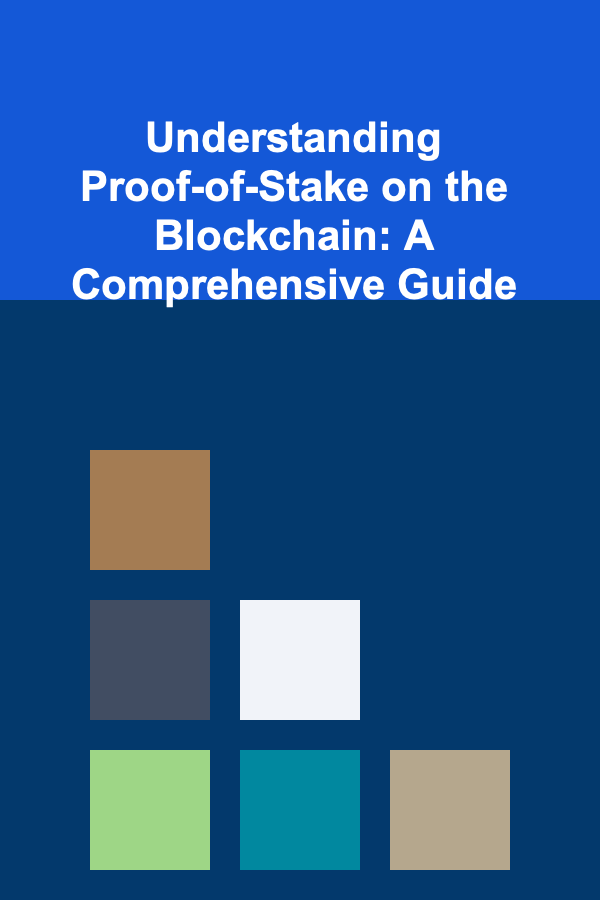
Understanding Proof-of-Stake on the Blockchain: A Comprehensive Guide
ebook include PDF & Audio bundle (Micro Guide)
$12.99$6.99
Limited Time Offer! Order within the next:

Proof-of-Stake (PoS) has emerged as a prominent consensus mechanism in the blockchain world, offering a compelling alternative to the energy-intensive Proof-of-Work (PoW). This article delves into the intricacies of Proof-of-Stake, exploring its underlying principles, variations, advantages, disadvantages, and its impact on the blockchain ecosystem. We will cover not only the core concepts but also advanced topics such as staking derivatives, liquid staking, and the evolving landscape of PoS implementations. Furthermore, we'll discuss security considerations, economic incentives, and the philosophical underpinnings that differentiate PoS from other consensus algorithms.
The Genesis of Consensus: Why Do We Need It?
Before diving into the specifics of Proof-of-Stake, it's crucial to understand the fundamental problem it aims to solve: achieving consensus in a decentralized and trustless environment. In a traditional centralized system, a single authority dictates the rules and validates transactions. However, blockchains are designed to operate without such a central authority. This decentralization necessitates a mechanism to ensure that all participants agree on the state of the blockchain -- that is, the order and validity of transactions.
The "Byzantine Generals Problem" is a classic computer science analogy that illustrates this challenge. Imagine a group of generals surrounding a city, needing to agree on a single attack plan. Some generals might be traitors trying to sabotage the attack. The challenge is to devise a communication system that allows the loyal generals to reach a consensus, even in the presence of these traitors. Blockchain consensus mechanisms, like PoS, are designed to solve a similar problem: allowing nodes in a distributed network to agree on the valid state of the blockchain, even if some nodes are malicious or faulty.
Proof-of-Work: The Original Consensus Mechanism
Bitcoin pioneered the concept of a decentralized consensus mechanism with its Proof-of-Work (PoW) algorithm. In PoW, miners compete to solve complex cryptographic puzzles. The first miner to find a solution broadcasts it to the network, and other nodes verify the solution's validity. If the solution is valid, the block containing the solution is added to the blockchain, and the miner is rewarded with newly minted coins and transaction fees. The difficulty of the puzzle is adjusted dynamically to maintain a consistent block creation rate.
While PoW has proven to be robust in securing the Bitcoin network, it has significant drawbacks. The primary concern is its enormous energy consumption. Solving the cryptographic puzzles requires specialized hardware and vast amounts of electricity. This energy consumption has raised environmental concerns and has led to calls for more energy-efficient consensus mechanisms. Another disadvantage is the potential for centralization. Mining pools, which pool computational resources, have become dominant in the Bitcoin mining landscape, leading to concerns about the concentration of power.
Proof-of-Stake: A More Efficient Alternative
Proof-of-Stake (PoS) offers a compelling alternative to PoW by replacing computational power with stake in the network as the basis for consensus. In a PoS system, users "stake" a certain amount of their cryptocurrency holdings to become validators. Validators are responsible for creating new blocks and verifying transactions. The probability of being selected to create the next block is typically proportional to the amount of stake a validator holds. The more tokens a validator stakes, the higher their chances of being chosen.
Instead of competing to solve cryptographic puzzles, validators in a PoS system are chosen randomly based on their stake. This eliminates the need for energy-intensive computations. When a validator is selected to create a new block, they verify the transactions in the block and sign it with their private key. Other validators then attest to the validity of the block. If a sufficient number of validators attest to the block, it is added to the blockchain.
Key Concepts in Proof-of-Stake
- Staking: The act of locking up a certain amount of cryptocurrency to participate in the consensus process.
- Validator: A node that has staked cryptocurrency and is eligible to create new blocks and verify transactions.
- Block Creation (Forging/Minting): The process of creating a new block and adding it to the blockchain. In PoS, this is often referred to as "forging" or "minting" rather than "mining."
- Slashing: A penalty imposed on validators who engage in malicious behavior, such as double-signing or attempting to rewrite the blockchain. Slashing typically involves the loss of a portion of their staked tokens.
- Stake Weight: The amount of cryptocurrency a validator has staked, which determines their probability of being selected to create new blocks.
Variations of Proof-of-Stake
While the core principle of PoS remains the same, there are numerous variations of the algorithm, each with its own strengths and weaknesses. Some of the most notable variations include:
Delegated Proof-of-Stake (DPoS)
Delegated Proof-of-Stake (DPoS) is a variation of PoS in which token holders vote for a limited number of delegates to act as validators. These delegates are responsible for producing blocks and maintaining the network. The key difference between DPoS and traditional PoS is the delegation of voting power. Instead of all token holders directly participating in block creation, they delegate their voting rights to a smaller group of delegates. This can lead to faster transaction speeds and higher scalability, but it also raises concerns about centralization if a small number of delegates control a significant portion of the network.
EOS is a notable example of a blockchain that utilizes DPoS.
Leased Proof-of-Stake (LPoS)
Leased Proof-of-Stake (LPoS) allows users who don't have enough tokens to become validators to lease their tokens to existing validators. In exchange for leasing their tokens, the users receive a portion of the validator's block rewards. This mechanism allows users with smaller holdings to participate in the consensus process and earn rewards.
Waves is an example of a blockchain using LPoS.
Bonded Proof-of-Stake
Bonded Proof-of-Stake requires validators to lock up their tokens for a specific period. This "bonding" period helps to prevent validators from quickly withdrawing their stake after engaging in malicious behavior. It adds an extra layer of security to the network by ensuring that validators have a vested interest in the long-term health of the blockchain.
Liquid Proof-of-Stake
Liquid Proof-of-Stake addresses a key challenge with traditional staking: the illiquidity of staked assets. When users stake their tokens, they are typically locked up and unavailable for other purposes. Liquid staking allows users to stake their tokens while retaining access to a liquid representation of their stake, often in the form of a staking derivative token. This derivative token can be used for trading, lending, or other DeFi applications, providing stakers with greater flexibility and capital efficiency.
Lido Finance is a prominent example of a platform offering liquid staking solutions for various blockchains.
Advantages of Proof-of-Stake
Proof-of-Stake offers several advantages over Proof-of-Work:
- Energy Efficiency: PoS consumes significantly less energy than PoW, making it a more environmentally friendly consensus mechanism. This is a major driver of its adoption.
- Scalability: PoS can potentially achieve higher transaction throughput and faster block creation times compared to PoW.
- Security: PoS can be more resistant to 51% attacks than PoW. In a PoW system, an attacker with 51% of the network's hashing power can potentially control the blockchain. In a PoS system, an attacker would need to acquire 51% of the staked tokens, which would be significantly more expensive and difficult.
- Lower Barrier to Entry: Becoming a validator in a PoS system is typically less expensive than becoming a miner in a PoW system. This can lead to greater decentralization.
Disadvantages and Challenges of Proof-of-Stake
Despite its advantages, PoS also faces several challenges and criticisms:
- Nothing at Stake Problem: This is a potential vulnerability in some PoS implementations where validators can vote on multiple conflicting forks of the blockchain without any significant penalty. If a validator can validate on multiple forks without risk, they maximize their potential rewards but undermine the integrity of the blockchain. Modern PoS systems mitigate this through slashing penalties.
- Centralization Concerns: Wealthier token holders may accumulate a disproportionate amount of stake, leading to centralization of power within the network. Mechanisms like delegated proof-of-stake, while offering efficiency, can further exacerbate centralization risks.
- "Rich Get Richer" Effect: Validators who have more stake tend to earn more rewards, which allows them to accumulate even more stake. This can create a feedback loop that concentrates wealth and power in the hands of a few.
- Complexity: PoS algorithms can be more complex to implement and analyze than PoW algorithms. This complexity can introduce new vulnerabilities and challenges.
- Initial Distribution of Tokens: The initial distribution of tokens can significantly impact the fairness and decentralization of a PoS system. If a small number of individuals or entities control a large percentage of the tokens, they can exert undue influence over the network.
- Cold Staking Risks: Cold staking involves staking tokens from an offline wallet for enhanced security. However, it can introduce complexities in managing private keys and ensuring consistent online availability for participation when called upon for validation.
Security Considerations in Proof-of-Stake
Security is paramount in any blockchain consensus mechanism. Proof-of-Stake systems employ various techniques to mitigate potential security risks. These include:
- Slashing: As mentioned earlier, slashing is a crucial mechanism for deterring malicious behavior. Validators who engage in double-signing, or other forms of attacks risk losing a portion or all of their staked tokens.
- Bonding: Requiring validators to lock up their tokens for a specific period helps to prevent them from quickly withdrawing their stake after engaging in malicious behavior.
- Random Validator Selection: Selecting validators randomly based on their stake helps to prevent collusion and makes it more difficult for attackers to predict who will be chosen to create the next block. Sophisticated randomness beacons are often used to ensure verifiable randomness.
- Economic Incentives: Designing the system with appropriate economic incentives is crucial for encouraging validators to act honestly. The rewards for validating honest blocks should outweigh the potential gains from engaging in malicious behavior, even considering sophisticated attack strategies.
- Byzantine Fault Tolerance (BFT): Many PoS implementations incorporate BFT principles to ensure that the system can tolerate a certain number of faulty or malicious nodes. BFT algorithms, such as Tendermint, are designed to guarantee consensus even in the presence of Byzantine failures.
Economic Incentives in Proof-of-Stake
The economic incentives within a PoS system are designed to encourage validators to act in the best interests of the network. These incentives typically include:
- Block Rewards: Validators are rewarded with newly minted coins and transaction fees for creating new blocks.
- Transaction Fees: Validators collect transaction fees from the transactions included in the blocks they create.
- Inflation: Some PoS systems use inflation to incentivize staking. New coins are minted and distributed to validators as staking rewards, incentivizing them to lock up their tokens and participate in the consensus process.
The design of these economic incentives is crucial for ensuring the long-term security and stability of the network. If the rewards for staking are too low, validators may be less incentivized to participate, which could weaken the network's security. Conversely, if the rewards are too high, it could lead to excessive inflation and devalue the cryptocurrency.
The Evolving Landscape of Proof-of-Stake
Proof-of-Stake is a rapidly evolving field, with new innovations and implementations emerging constantly. The transition of Ethereum from Proof-of-Work to Proof-of-Stake ("The Merge") has been a watershed moment, significantly increasing the visibility and adoption of PoS. Researchers and developers are continually working to address the challenges and limitations of PoS and to develop new and improved consensus mechanisms.
Some of the key trends in the evolution of Proof-of-Stake include:
- Increased Adoption of Liquid Staking: Liquid staking is becoming increasingly popular as a way to address the illiquidity of staked assets. More and more platforms are offering liquid staking solutions, allowing users to stake their tokens while retaining access to a liquid representation of their stake.
- Hybrid Consensus Mechanisms: Some blockchains are exploring hybrid consensus mechanisms that combine elements of PoW and PoS. These hybrid approaches aim to leverage the strengths of both algorithms while mitigating their weaknesses.
- Improvements in Security: Researchers are constantly working to develop new and improved security techniques for PoS systems. This includes advancements in slashing mechanisms, validator selection algorithms, and Byzantine Fault Tolerance protocols.
- Focus on Decentralization: There is a growing emphasis on designing PoS systems that are more decentralized and resistant to centralization risks. This includes exploring new governance models and mechanisms for distributing staking power more evenly.
- Interoperability of Staked Assets: As the DeFi landscape matures, there's a growing interest in interoperability, particularly for staked assets. Enabling staked tokens to be used across different chains and applications is a key focus.
- Modular Blockchain Design: Modular blockchains separate different functions like execution, settlement, and consensus into distinct layers. This allows for greater flexibility and optimization, including exploring different PoS mechanisms for the consensus layer.
Proof-of-Stake and its Philosophical Underpinnings
Beyond the technical aspects, Proof-of-Stake represents a shift in the philosophical foundations of blockchain consensus. While Proof-of-Work relies on external resources (energy) to secure the network, Proof-of-Stake relies on the internal economic incentives of the network itself. This distinction highlights different approaches to trust and security.
PoW's reliance on energy consumption can be seen as a form of "objective" security, as the cost of attacking the network is directly tied to the physical resources required. However, this comes at the expense of environmental sustainability. PoS, on the other hand, relies on the alignment of economic interests between validators and the network. The more a validator has at stake, the more they are incentivized to act in the best interests of the network.
The choice between PoW and PoS (and their various iterations) often reflects different priorities and values. PoW proponents emphasize its robustness and proven track record, while PoS advocates highlight its energy efficiency and potential for greater scalability. Ultimately, the optimal consensus mechanism for a particular blockchain depends on its specific goals and requirements.
Conclusion
Proof-of-Stake has emerged as a compelling and increasingly popular alternative to Proof-of-Work in the blockchain world. Its energy efficiency, potential for scalability, and lower barrier to entry make it an attractive option for many blockchain projects. While PoS faces its own challenges, such as the "nothing at stake" problem and centralization concerns, ongoing research and development are continually addressing these issues and improving the security and efficiency of PoS systems.
As the blockchain ecosystem continues to evolve, Proof-of-Stake is likely to play an increasingly important role in securing and scaling decentralized networks. Understanding the intricacies of PoS, its variations, and its advantages and disadvantages is essential for anyone seeking to participate in and contribute to the future of blockchain technology.

How to Clean Your Windows and Keep Them Sparkling
Read More
How to Establish a System for Incoming Mail and Paperwork
Read More
How to Handle Moving Insurance and Claims
Read More
How to Develop Your Public Speaking Skills as a Leader
Read More
How to Design Basic AR Experiences
Read More
Finding Happiness Through Ancient Philosophy
Read MoreOther Products

How to Clean Your Windows and Keep Them Sparkling
Read More
How to Establish a System for Incoming Mail and Paperwork
Read More
How to Handle Moving Insurance and Claims
Read More
How to Develop Your Public Speaking Skills as a Leader
Read More
How to Design Basic AR Experiences
Read More